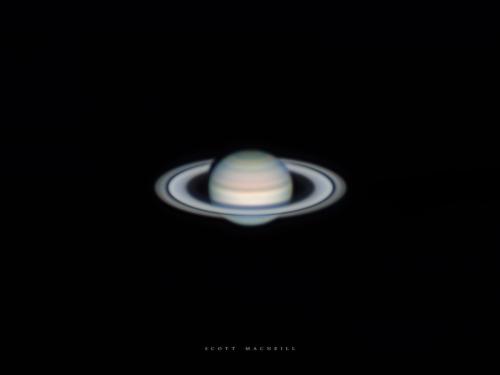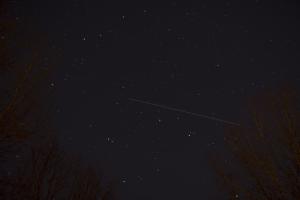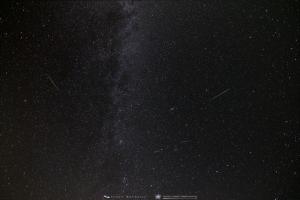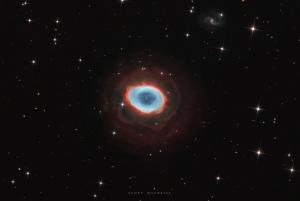Celebration of Space - August 12, 2022

Saturn at Frosty Drew Observatory in 2021. Credit: Frosty Drew Astronomy Team member, Scott MacNeill
This coming Sunday, August 14, 2022, Earth will reach the point in our orbit where Saturn will be on the opposite side of Earth than the Sun. We call this opposition, and it places Saturn in best viewing for the year. During opposition, Saturn will rise at sunset, and set at sunrise. It is also when we are the closest to Saturn for our year. The weeks around opposition are the best time to view Saturn, which places us in that time frame right now.
Now that Saturn is coming into opposition, all the bright naked eye-visible planets, that have been hanging around in the morning sky for the past 8 months, are now starting to return to the nighttime sky. Jupiter’s opposition will occur next, on September 26th, followed by Mars’ on November 18th. Once Saturn’s opposition passes, Saturn will rise before the Sun sets, making it increasingly easier to see after sunset. Make plans over the next couple months to stop in at Frosty Drew Observatory and catch a stunning view of Saturn’s rings, equatorial bands, and moons in the big telescope.
Also on Sunday, August 14, 2022, evening passes of China’s space station – Tiangong will return to the sky over the United States, specifically the Northeast. Tiangong is one of the brighter objects that we can see passing over, it is not as bright as the International Space Station (ISS) but it is close. With a couple amazing passes slated for the coming week, getting out to catch a view should be high on your evening priority list. Here are some notable passes of Tiangong for the coming week:
Sun, Aug 14 at 9:15 pm, starting in SSW, rising to 20º, and into orbital sunset
Mon, Aug 15 at 9:52pm, starting in the WSW, rising to 21º, and into orbital sunset
Tue, Aug 16 at 8:52 pm, starting in the SW, rising to 40º, heading towards the ESE and into orbital sunset
Wed, Aug 17 at 9:30 pm, starting in the WSW, rising to 76º, and into orbital sunset ← Awesome pass!
Thu, Aug 18 at 8:31, starting in the WSW, rising to 60º, heading towards the E, and into orbital sunset ← Awesome pass!
Orbital sunset occurs when the station, or object you are observing, enters Earth’s shadow, which will cause the station to quickly fade out of view. For the ISS and Tiangong, this happens once every 90 minutes. Residents residing on the station will experience sunset during that time, and residents of Earth that are watching the station pass will experience the station fading out of view until it disappears. For daily pass times of Tiangong, and other bright satellites, visit the Frosty Drew Daily Satellite Pass Prediction Utility.
Now that the Perseid Meteor Shower peak is coming to an end, there are still a few opportunities to catch a view of Perseid meteors. At Frosty Drew we have observed a rather spectacular post-peak showing of Perseid meteors over the years, not necessarily as good as the peak night, but well worth a watch. The Moon will continue to be an issue, even though it will be retreating into the morning sky as it continues to wane. But give it a go later this weekend if you find yourself under a clear sky, and you just may spot several Perseid meteors.
Over the past month at Frosty Drew Observatory, we have been busy working with the new PlaneWave CDK600 24 inch telescope. One of the tasks we are accomplishing with it is our Project Messier project. Which is an attempt at fully re-imaging all 110 deep sky objects that make up the famous Messier Catalog. Our latest addition to the project is the fabulous Ring Nebula – Messier 57 (M57). Here is the image that we captured during July of the Ring Nebula. This object is a very interesting object, and a fan favorite for those who visit in the dark nights with no Moon. M57 is a small-mid mass star that has recently died. During this process all fusion has ceased in the core of the star. Eventually the core of the star became exposed to space, and all the outer layers of the star have started to detach as an expanding gas cloud. Now the core of the star is very hot, and is radiating intense amounts of ultraviolet radiation into the expanding gas cloud, ionizing it. The result of this process causes the surrounding gas cloud to glow. This process will continue for 10,000 years, after which the gas cloud will become invisible, yet continue to expand, and all that will remain is the dead core of the star, which is now a white dwarf star.
- Author:
- Scott MacNeill
- Entry Date:
- Aug 12, 2022
- Published Under:
- Scott MacNeill's Columns




